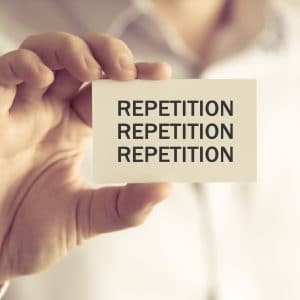Exciting email marketing success for one of our clients reinforced for me the universal “truthiness” of certain marketing principles and reminded me of the evolving nature of our business – effective communications.
Some history: I began my career as an advertising media planner. Then, just as planners today, I was schooled in the industry maxims of reach and frequency, and the primacy of frequency – reaching target markets a minimal number of times to achieve impact.
 Repeating is believing: From a psychology perspective, research shows that repeated statements are believed to be more truthful than those made less frequently “presumably because repetition imbues the statement with familiarity.” (Read more at Say It Again: Messages Are More Effective When Repeated)
Repeating is believing: From a psychology perspective, research shows that repeated statements are believed to be more truthful than those made less frequently “presumably because repetition imbues the statement with familiarity.” (Read more at Say It Again: Messages Are More Effective When Repeated)
What’s old is new: From Ebbinghaus’s “learning curve” and Thomas Smith’s Successful Advertising (both dating to the 19th Century!), to Herbert E. Krugman and John Philip Jones, both in the late 20th Century, and studies from Facebook, etc. now, there have been countless models and theories on achieving effective frequency levels.
But how much frequency is the right amount? There is no one answer, although some say the right amount can be one. Typically, analyses peg effective frequency from 3 to 20+ exposures.
In our client’s B2B email marketing case, frequency was geared toward helping the client engage prospects with an average six-figure revenue value. We saw that more than one exposure was necessary and that the range of 3-20 was a starting point.
The story: Our client met a prime prospect at their tradeshow booth. Her card was collected, and as planned, a follow-up “good to meet you” email was sent immediately after the show and followed by a series of emails designed to educate and engage the prospect, serving up offers of content and opportunities to connect again in person. The email outreach plan was designed:
Week 1 – Sent tradeshow follow-up
Week 2 – Sent “Campaign A” #1
Week 3 – Sent “Campaign A” #2
Week 4 – Sent “Campaign A” #3
Week 8 – Prospect visited website (viewing 9 pages over 5 minutes) and received follow-up email
Week 12 – Sent “Campaign B” #1
Week 15 – Sent “Campaign B” #2
Week 17 – Sent “Campaign B” #3
With that eighth email in Week 17, our prospect clicked on the “Please Contact Me” link and a client sales person reached out to schedule a meeting and pursue this now red-hot lead with an anticipated six-figure sales value. So, for this scenario, eight was the effective frequency level, but those eight exposures are certainly different from the old contacts we had imagined when I started building media plans.
These weren’t eight views of a 30 second commercial or a full-page print ad, at a multi-million-dollar spend. These were eight highly targeted email contacts, at a much LOWER spend. These messages were sent with identifiable intent to one prospect; messages with offers of relevant content and information based on a growing body of knowledge being acquired about her. Although our target did not request to be contacted until the eighth outreach, each arguably served as a prompt, keeping our client’s name top-of-mind, differentiated and relevant for when the moment would be right.
This new business lead might have also encountered our marketing messages via the industry newsletter blasts purchased for our client, or one of our search ads via Google AdWords or one of the bylined articles we had developed and placed in key trade publications. So, the frequency of our reach was likely higher than the eight we can quantify, but clearly, frequency played a role in converting this target to an active lead.
Reaching the point of sale is a process. Marketing is about exciting your audience about your offering. This anecdote is just one piece of the measured pie tracked with and by our client. These measurements allow them to demonstrate that marketing is not a cost center, but a business-building, revenue-generating, brand investment. And stories like this one keep a marketer’s blood pumping (to paraphrase our client)!
When it comes to frequency there is no single right answer, but frequency is key to success. And from the 19th Century to the 21st Century, the consensus is that messages – in newspapers, magazines or TV then, or search engines, social media or email today – are more effective when they are repeated. It makes them more believable, too. So, once again, please repeat after me: Frequency Matters.
Rob Beltran
Robert Beltran is a Senior Partner at Lumentus and is one of the firm’s founding partners. Rob relies on his broad, cross-industry experience to provide strategic counsel and direction around all “Paid” engagements and integrated marketing assignments undertaken on behalf of clients. He built his reputation working with an array of industry-leading companies and some of the world’s most recognized brands, including The Coca-Cola Company, Colgate-Palmolive, LG Appliances, UBS, CEMEX, FMC Technologies, Leviton Manufacturing, Advil Cold & Sinus and the U.S. Postal Service.